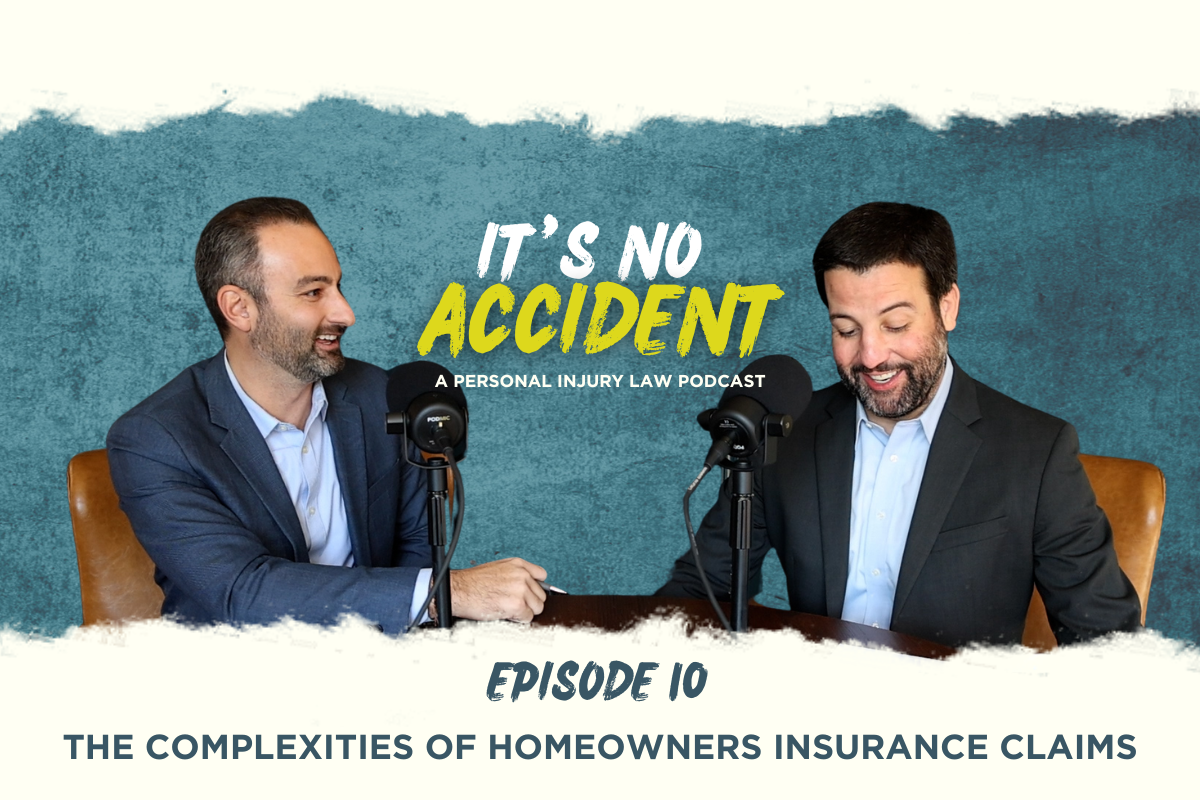
Podcast Description
In this episode of ‘It’s No Accident’, hosts Mark Nonni, Jaeson Homola, and Chris Ferraro explore the challenges homeowners face with insurance companies after storm damage. Learn the essential steps to take immediately post-storm, including filing claims and documenting damages. The group covers the importance of collaborating with insurance adjusters, understanding insurance policy details, and recognizing when legal help is needed. Discover the roles of public adjusters and the risks of hiring non-local contractors. Tune in to safeguard your home with expert advice and actionable insights.
Episode Transcript
We’re predicted to have a pretty severe storm season ahead. There’s a good chance a major storm could come through. If that happens and significantly damages someone’s home, and the homeowner contacts their insurance company to assess coverage, at what point should they involve an attorney? When does someone know it’s time to call a lawyer?
The first and most important step is to file the claim. Typically, the insurance company will assign an adjuster within two weeks, and they are legally obligated to notify you and let you know when the adjuster will visit.
During the adjuster’s inspection, it’s crucial to walk through your home with them. Point out every area you know to be damaged. If you don’t, they may only do a brief inspection—they’re often visiting several homes a day and can rush through the process. Ensure they’re aware of every damaged spot, even though that doesn’t guarantee it will be included in their estimate.
Most people aren’t experts in construction, but the insurance adjuster should recognize where damage is likely to occur. After their inspection, they’ll evaluate the damages using a program called Xactimate. The company will then send you their assessment and a claims determination detailing what’s covered and how much they’re willing to pay.
In about 95% of cases, people are not satisfied with the initial number. But what many don’t realize is that the insurer still has an obligation to cover all legitimate damages. If the estimate is low—say $10,000—it’s best to get a reputable, local contractor to provide a competing bid. Submit that bid to your insurer and point out the discrepancies. This gives them a chance to reassess the claim and possibly increase their offer.
Ideally, this back-and-forth resolves the matter without needing legal help. However, you’ll know you need an attorney when the insurance company stops cooperating, refuses to acknowledge the contractor’s estimate, or won’t budge from an unreasonably low number.
What about public adjusters? They’re often mentioned after major storms. Are they useful?
Public adjusters perform similar assessments to the insurer’s adjusters. They also use estimating software and prepare their own damage reports. Sometimes, they can increase the value of a claim. However, they lack real leverage—they can’t sue or force the insurance company’s hand. While they may be helpful, if you’re facing major pushback, an attorney is often more effective.
Think of it like a kid begging for candy in a store. The parent can say no because the child can’t do anything about it. Similarly, insurers can ignore a public adjuster’s request without consequence. An attorney, however, can compel action through legal means.
Also, many people make the mistake of accepting a low estimate without knowing their rights. Insurance companies often pay based on “actual cash value” (ACV)—the replacement cost minus depreciation. For example, if you have a 30-year roof that’s 15 years old and the replacement cost is $10,000, they might deduct your $1,000 deductible and $5,000 in depreciation, paying you only $4,000.
However, if you repair the damage within the contract’s timeline (usually within a year), you’re entitled to recover that $5,000 in depreciation. Many homeowners don’t realize this and assume they’re stuck with a payment that’s far too low.
Another key issue is the duty to mitigate damage. Nearly all insurance policies include a clause that requires homeowners to take reasonable steps to prevent further damage. This includes things like tarping roofs, sealing broken windows, or shutting off leaking pipes. First and foremost, ensure your family’s safety. Then, do what you can to stop additional damage while waiting for the adjuster.
Often, after storms, out-of-state contractors swarm affected areas. While some are legitimate, it’s best to work with local, reputable, insured professionals whenever possible. Out-of-town contractors may disappear after doing subpar work and leave you with no recourse.
Finally, many homeowners feel like they’re fighting battles on all sides—insurance companies, contractors, roofers—when all they want is their home restored and their investment protected. Contractors from out of town don’t have a reputation to maintain in your community and may not care about service quality.
To sum up:
- Take detailed photos of your property before and after the storm.
- File your claim promptly.
- Cooperate and provide the requested documentation.
- If your insurer’s estimate is insufficient, get a contractor’s bid.
- Submit the bid and request appropriate compensation.
- If the insurance company refuses to cooperate, it’s time to speak with an attorney.
It’s important to remember—you can’t just tell your insurer, “this is broken, fix it.” Provide documentation and bids. Do your best to resolve the issue directly. But if they stop working with you, then it’s time to escalate.


